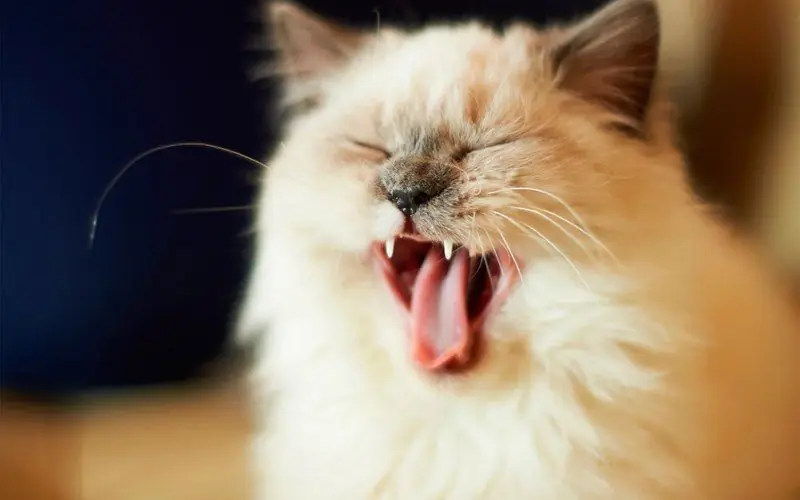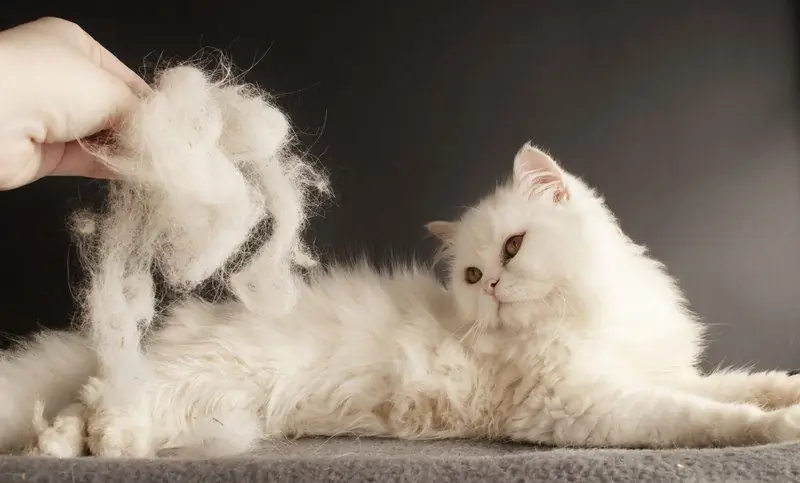
Table of contents:
- Author Bailey Albertson [email protected].
- Public 2024-01-17 22:26.
- Last modified 2025-01-23 12:41.
Staying Alive: Cat Ears Care

Not all cat owners regularly groom their pets' ears, and this is not always required. But in a number of situations, for example, when acquiring a cat of a certain breed or developing otitis media in an animal that has not previously caused problems, it becomes necessary to quickly and fully master the skills of caring for the ears, since the health of the pet depends on it.
Content
-
1 Causes of ear contamination in cats
- 1.1 Photo gallery: cat breeds requiring increased care of ear hygiene
- 1.2 Table: ear diseases in cats
-
2 Preventive ear cleaning at home
-
2.1 Means for preventive cleaning of ears in cats
2.1.1 Photo Gallery: Ear Cleaners
- 2.2 How to clean your ears
-
2.3 Additional Ways to Deal with Cat Protest
1 Photo gallery: ways to immobilize a cat
- 2.4 Features of ear treatment in kittens
- 2.5 Video: how to properly clean a cat's ears
-
-
3 Cleaning the ears for otodecosis and other diseases
-
3.1 Cleaning at home
- 3.1.1 Otodecosis
- 3.1.2 Otitis media
- 3.1.3 Scratches and other damage
- 3.1.4 Photo gallery: ear diseases in cats
- 3.2 Cleaning the ears in the clinic
-
- 4 Advice from veterinarians
Causes of ear pollution in cats
Normally, the skin of the ear canal of cats secretes earwax with the help of special ceruminous glands. Earwax is a mixture of proteins, lipids, fatty acids and mineral salts. It performs a protective function and has an acidic reaction, which inhibits the growth of bacteria and fungi, and also contains a small amount of immunoglobulins, which is an additional protective factor. Usually, earwax, having absorbed dust, microbial particles, as well as dead epithelial cells and sebum, goes outside on its own and does not require human intervention. Normally, earwax is light yellow, odorless. The cat itself carefully cleans its ears with its paws.
Ears can get dirty due to the peculiarities of their anatomy:
- large open ears get dirty more quickly than standard size ears;
- poorly covered with wool get dirty faster than shaggy ears;
- with a hanging auricle, ventilation of the ear canal deteriorates, the local temperature rises, thereby improving the conditions for the reproduction of bacteria and fungi, and the ear responds to this with increased formation of earwax.
The cleanliness of the ears is affected by environmental pollution, as well as the habits of the cat itself.
Photo gallery: cat breeds requiring increased care of ear hygiene
-

Dwarf cat next to an apple - Big ears in Dwarf breed are very vulnerable
-

Scottish Fold cat -
Scottish Fold ears should be examined frequently
-

Sphynx cat - The ears of Sphynx cats are very susceptible to dirt
Also, ear contamination may indicate the development of diseases.
Table: cat ear diseases
| Name | Cause | Description |
| Otodectic mange (ear scabies) | Caused by ear mites, it is the most common cause of otitis externa in cats. | Ticks cause severe itching, the cat intensively scratches its ears and shakes its head. In the ear - copious brown or red-brown odorless discharge, redness, scratching. |
| Otitis externa | Caused by bacteria and fungi. | Discharge from the ear, possibly odorless; redness, scratching, pain and associated depression. |
| Solar dermatitis in white and hairless cats | Due to the deficiency of the skin pigment melanin, these cats are highly susceptible to sunburn. | First, there is a moderate reddening of the auricle, the hair thinns, gradually due to chronic inflammation, the skin thickens, itching, scratching occurs, a favorable environment is created both for the attachment of a microbial infection and for the development of squamous cell carcinoma. |
| Allergy | The allergen can be anything. | Manifested by allergic otitis media with discharge, itching, redness and possible peeling of the skin of the ears. |
Normal erect ears require a weekly examination; the ears of self-walking cats are examined every day. The ears of breeds such as the Sphynx, Scottish Fold, Dwelf, and other similar breeds are also checked daily.
When examining the ears, pay attention to:
- accumulation of sulfur and dirt;
- the nature of the discharge;
- the presence of a smell;
- the presence of scratching;
- redness and inflammation;
- blood, scratches, hematomas (accumulation of blood in tissues), lymphoextravasates (accumulation of lymph in tissues) - all these are the consequences of injuries;
- tumors.
Any deviation from the norm revealed during the examination of the auricle is a reason for visiting a veterinarian.
It is important to check your ears regularly, but clean them only if they are dirty. Regular erect ears may not require cleaning at all, or they can be cleaned about once every two weeks. The ears of cats of “problem” breeds are cleaned daily. The ears of cats are self-walking - depending on the degree of their pollution. If the cat has otitis media, the auricle is sanitized twice a day, or even more often, according to the veterinarian's instructions.
Preventive ear cleaning at home
Cats should be taught to regularly check and clean their ears from an early age, as animal protests can add unwanted variety to manipulation.
Means for preventive cleaning of ears in cats
Specially produced care products are used to clean the ears:
- cleansing wet wipes - good for removing dirt, easy to use, especially convenient on the road;
- hygiene lotions - can contain both antiseptics and vegetable oils and extracts;
- hygienic ear drops - contain boric or salicylic acid, as well as plant extracts; they are buried shallowly into the external auditory canal in the dosage prescribed by the instructions, the ear is massaged;
- auricle care gels - also contain antiseptics and herbal ingredients;
- powder - contains iodoform, allows you to relieve irritation and prevents the growth of microflora; but veterinarians believe that the use of powder leads to the formation of sulfur plugs.
Photo gallery: ear cleaners
-

Cleansing Wet Wipes for Cat Ears - Wet wipes are easy to apply even when traveling
-

Hygienic lotions for cat ears - Lotions gently cleanse the auricle and remove impurities
-

Ear drops for cats - Ear drops can be both complex and aimed at treating a specific disease.
It is recommended to combine products from the same manufacturer's line when leaving. Given their complex composition, interaction and compatibility with products from another manufacturer is difficult to predict. For hygienic care, you cannot use products containing antibacterial drugs, only antiseptics are permissible, otherwise this will lead to chronic intractable otitis media caused by microflora resistant to antibiotics.
If you have not bought anything, but you need to clean your ears, you can use:
- an aqueous solution of chlorhexidine;
- Vaseline oil;
- saline (0.9% NaCl);
- clean water at room temperature is an extreme measure, but better than dirt.
Hydrogen peroxide, soap solutions, alcohol-containing liquids are not suitable for use
How is ear cleaning done?
Ear cleaning is carried out in approximately the following sequence:
-
Sit the cat on your knees and gently fix it, hugging it to you. If the cat breaks loose, you can hold it by the withers. If attempts to escape become more intense, the cat uses claws and teeth - swaddle it with a towel, fix its head with one hand, and use the other to examine the ear.

A cat in the lap of a woman who cleans his ear Keeping a cat while cleaning its ears can be tricky
- Examine the ear for discharge, inflammation, trauma; make sure there is no smell.
- If necessary, wipe the ear with a lotion tissue. Do not try to penetrate deep into the ear canal - it can be damaged or the wax can be compressed to form a plug; all manipulations with ear cleaning should be carried out within the line of sight. After applying the lotion, the napkin must first be wrung out, since excess moisture in the ear is unacceptable. Small dirt can be removed with cotton swabs, again, in the field of view; the ear should remain dry after cleaning.
- If the ear is very dirty, a few drops of lotion can be put into the ear canal and massage the base of the ear.
- Then wipe the lotion and dirt that has come out with a dry cloth.
- Free, praise, and treat the cat.
Additional Ways to Deal with Cat Protest
If there is no towel or it is difficult to use it, then:
- you can put the cat in a sports bag with a zipper and zip it up, leaving only the cat's head outside, additionally fix it with your knees;
- immobilize the cat by placing it in the sleeve of thick old clothes in such a way that only the head remains outside;
- take a special bag for holding cats, you can additionally use a muzzle for cats.
In all cases of restraining the cat, you need to make sure that it does not obstruct its breathing

Protective nail caps will help reduce the risk of nail injury
Photo gallery: ways to immobilize a cat
-

Muzzled cat - A muzzle will help from cat bites
-

Cat in a bag - A small sports bag can be used to fix the animal
-

The cat, wrapped in a towel, lies on the table - By wrapping a towel around your cat, you can protect yourself from its claws.
Features of ear treatment in kittens
Care for the kitten's auricle is carried out by wiping with a cotton pad with lotion. If it is necessary to clean the ear canal, use drops. It is not recommended to use cotton swabs, since they can easily injure the delicate ear with a sharp movement of the kitten.
Video: how to clean a cat's ears correctly
Cleaning the ears for otodecosis and other diseases
Ear cleaning for diseases can be carried out both at home and in a veterinary clinic.
Cleaning at home
It is important not to remove ear contents prior to the initial veterinarian visit, as this will complicate the diagnosis; before starting treatment, it is necessary to conduct a microscopy of the scraping and take crops. All medicinal prescriptions are made only by a veterinarian. Self-medication is dangerous due to the formation of antibiotic-resistant bacterial flora, the chronicity of the inflammatory process and its spread, including to the meninges, which will cause the death of the cat.
Otodecosis
Otodecosis does not pose a danger to humans, but in some cases allergic reactions are possible. Otodectic mange is dangerous to other cats as well as dogs. They can be treated with common drugs that prevent tick attacks. Cat ears are very sensitive, and the sensitivity of diseased ears increases significantly, so it is necessary to provide protection from the cat's teeth and claws by fixing it securely. A sick cat is more likely to react violently than a healthy cat.
Cleaning the ears with otodecosis includes the usual hygienic cleaning, as well as the application of medicinal products.
Good results are achieved with the following products:
- ointment 0.05% aversectin; it is abundantly applied to the entire inner surface of the auricle and the external auditory canal twice with a weekly interval between treatments;
- liniments tanacet or polysulfide; also applied twice, interval - 7 days;
- 3% creolin, topically, double treatment with an interval of 7 days;
- solutions of veterinary insectoacaricidal preparations: Neostomazan, Stomazan, Butoks, Ectomin, Baytikol, applied externally, twice with an interval of 10 days; the inner surface of the auricle, external auditory canal, hair on the ear and next to the ear are processed;
- gel Amidel Neo - inhibits cyfluthrin, which affects ticks; chlorhexidine for the treatment of concomitant bacterial inflammation, as well as lidocaine, which immediately relieves itching in the cat; after the usual cleaning of the auricle, the inner surface of the ear is carefully wiped with a napkin soaked in gel and 0.5 g of gel is squeezed into the ear lumen; the drug is supplied in a convenient form of a syringe-dispenser;
- amitrazine preparations (Amitraz, Tsipam) - they are treated 3-5 times with an interval of 4-5 days;
- Hexachloran preparations (Aurican) - instilled into the ear daily for a week, then 2 times a week for a month;
- also kill ear mites drops on the withers - Frontline, Stronghold, Bars.
It is possible to independently prepare a remedy for the treatment of an ear mite, if it is possible to get the components and this composition is approved by the attending veterinarian:
- 20 g of unsalted lard of pork;
- 8 g of potassium carbonate;
- 15 g of colloidal sulfur.
All components are thoroughly mixed and the resulting product is applied externally, with a frequency of once every 2-3 days, until the symptoms disappear completely.
Otitis
If the cause of the cat's malaise is otitis externa, then apply:
- ear drops - to affect the bacterial flora Otospectrin, Otobiovet, Otobiovin, Poliseptin; for additional impact on the accompanying fungal flora - Aurizon, Surolan, Mometamax, Izotic, Posatex;
- antibacterial drugs of a wide spectrum of action (according to indications) - Sinulox, Tsiprovet;
- painkillers - with severe pain syndrome - Loxicom.
A good help as a home remedy will be a cotton swab dipped in camphor alcohol, wrung out and left in the pet's ear for several hours under a compress.
Scratches and other damage
If scratches, abrasions, hematoma, lymphoextravasate are found in the ear, then:
- hematomas and lymphoextravasates are opened and emptied in a veterinary clinic, otherwise a focus of purulent inflammation is formed, during the healing of which a persistent ear deformation is formed; further processing is performed with chlorhexidine or Levomekol ointment;
- scratches and abrasions are treated with chlorhexidine.
Photo gallery: ear diseases in cats
-

A kitten with red ears lies on the table - With otitis externa in a kitten, reddening of the skin of the ears is noticeable
-

A man holding a cat ear - A hematoma of the outer ear in a cat can only be opened in a veterinary clinic
-

Otodectic mange in a cat - Otodectic mange caused by ticks
Ear cleaning in the clinic
Routine ear cleaning in a veterinary clinic is advisable if the owner has this first cat and has no experience in ear care at all. The clinic will explain and show you how to monitor your ears. Also, owners of aggressive animals can go to the clinic for hygiene and medical procedures. The cost of ear cleaning at a veterinary clinic varies from 150 to 750 rubles.
With a prolonged course of the disease and the formation of sulfur plugs, the distant part of the auditory canal becomes clogged, and the possibility of drug penetration there is reduced. In this case, in order to shorten the treatment time for otitis externa, a hardware ear wash can be prescribed. It is carried out under sedation using special rehabilitation systems such as the Welch Allyn device. The feasibility of carrying out is determined by the veterinarian. An absolute contraindication is violation of the integrity of the eardrum.
Veterinary advice
Caring for your ears is important for your cat's health and plays a crucial role in ear disease. The main role is played by regular examinations of the ears, which, if necessary, are supplemented by hygiene measures. Cats should be taught to inspect and clean their ears from childhood. If an ear disorder is suspected, the cat should be immediately examined by a veterinarian. Self-medication in this case can complicate the diagnosis and harm the cat. When performing medical prescriptions, the risk of aggression from a sick cat is high, therefore, precautions are necessary. The arsenal of remedies for the treatment of otitis media is wide, but will benefit only in the skilled hands of a veterinarian.
Recommended:
How Many Teeth An Adult Cat And A Cat Have, How To Clean Them At Home, Including How To Clean Them From Tartar Formation

Milk and molar teeth in cats, how many there are. How to brush your cat's teeth. Brushes and toothpastes for cats. Causes of tartar. Cleaning the oral cavity from the stone
One Or Both Eyes Of A Cat Or Cat Are Watering: Why, What To Do And How To Treat A Kitten And An Adult Animal At Home

Lachrymation in cats looks like it is formed. Causes of lacrimation in a healthy and sick pet, breed predisposition. Prevention
Why Does A Cat Or Cat Shed Heavily And What To Do If The Hair Climbs And Falls Out In Large Quantities In A Kitten And An Adult Animal

How is molting in cats normal? Features in different breeds. How to help a cat with normal and prolonged molting. Diseases manifested by abundant molting
Cat's Or Cat's Eyes Fester: Reasons For What To Do And How To Treat A Kitten And An Adult Animal At Home, How To Wash It Out Of Pus

What does purulent discharge from the eyes look like in cats? For what diseases does the symptom occur? How is it treated. Care recommendations. Preventive measures
DIY Toys For Cats And Cats: How To Make At Home, What Accessories To Prefer For A Kitten And An Adult Animal

The need for toys in a cat's life, types of homemade toys and their phased production at home
